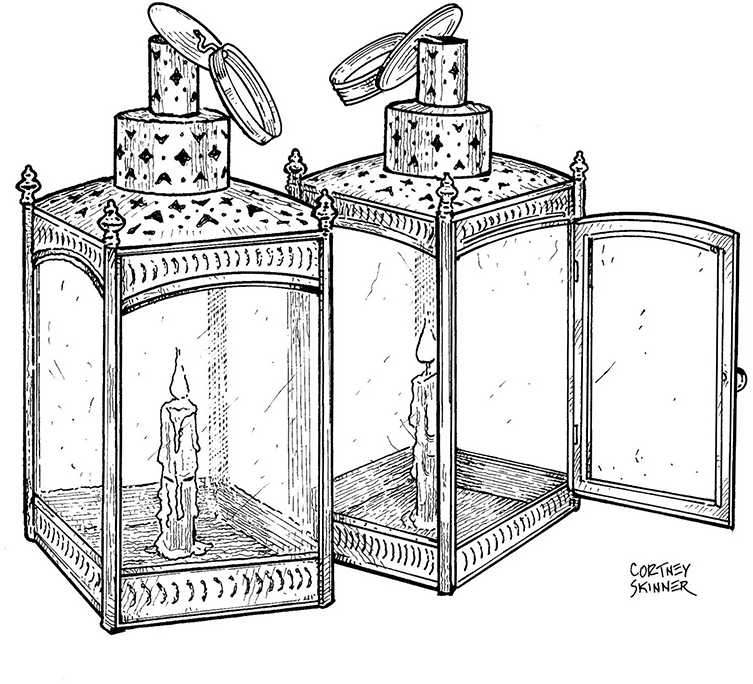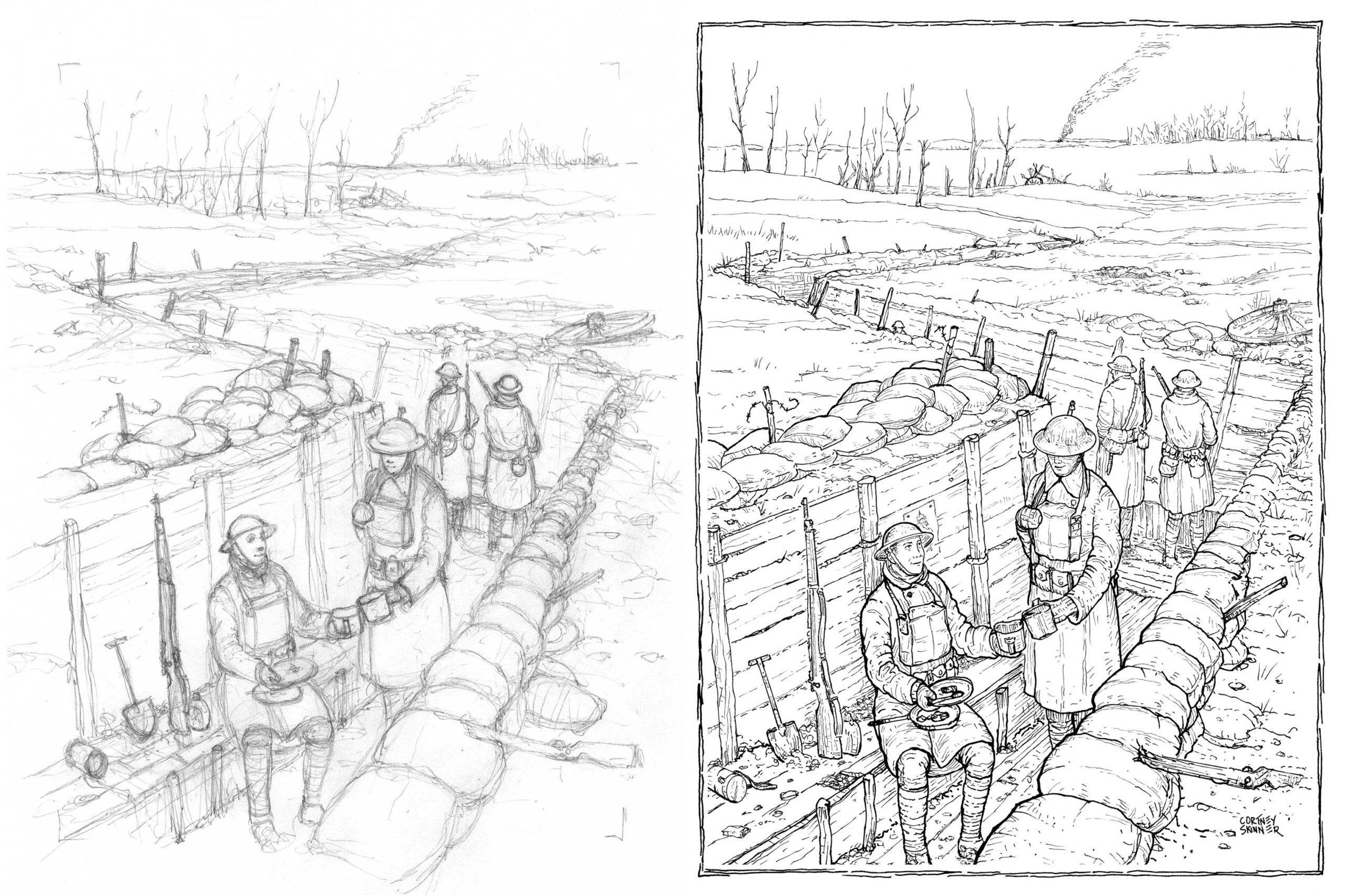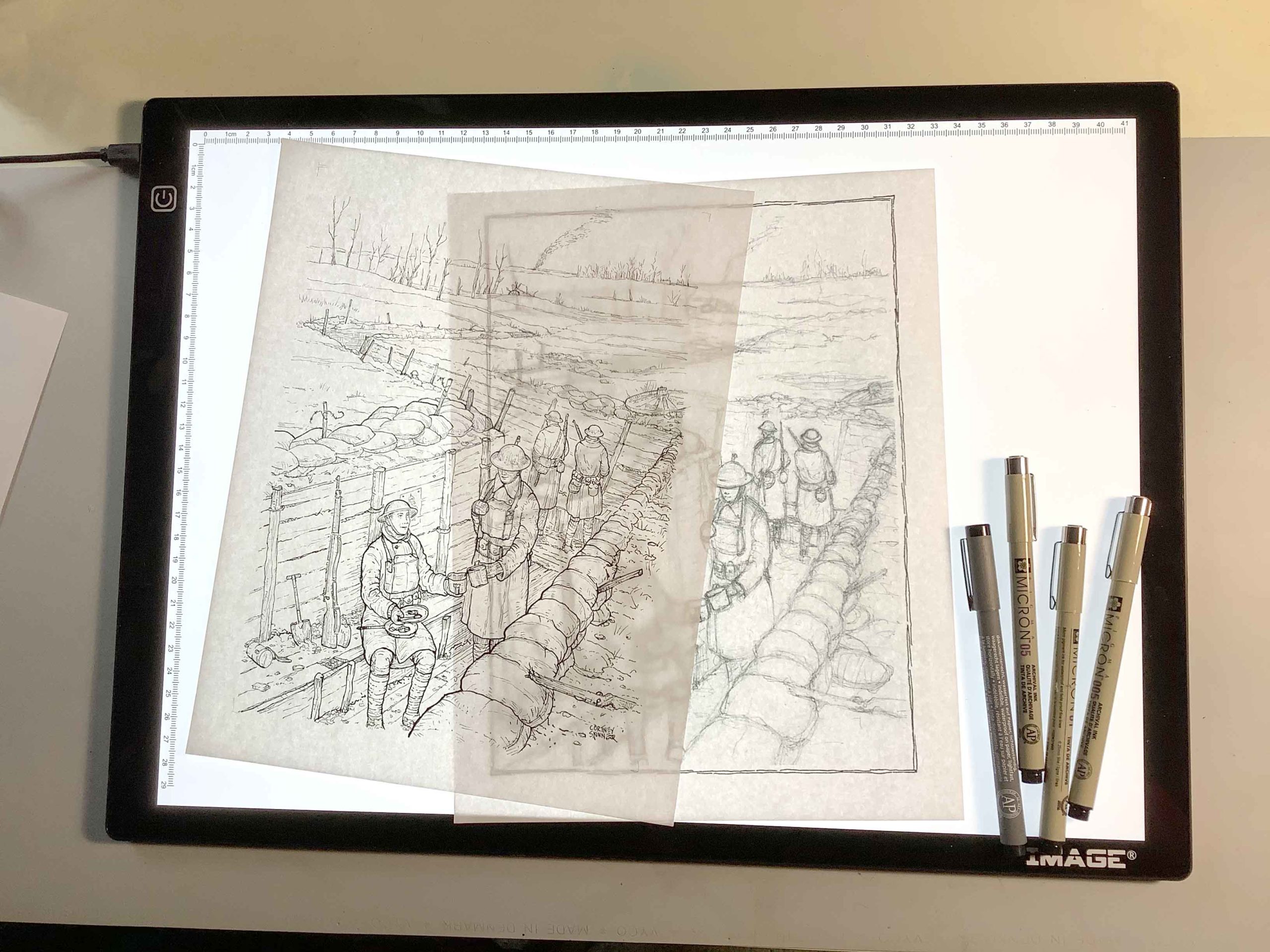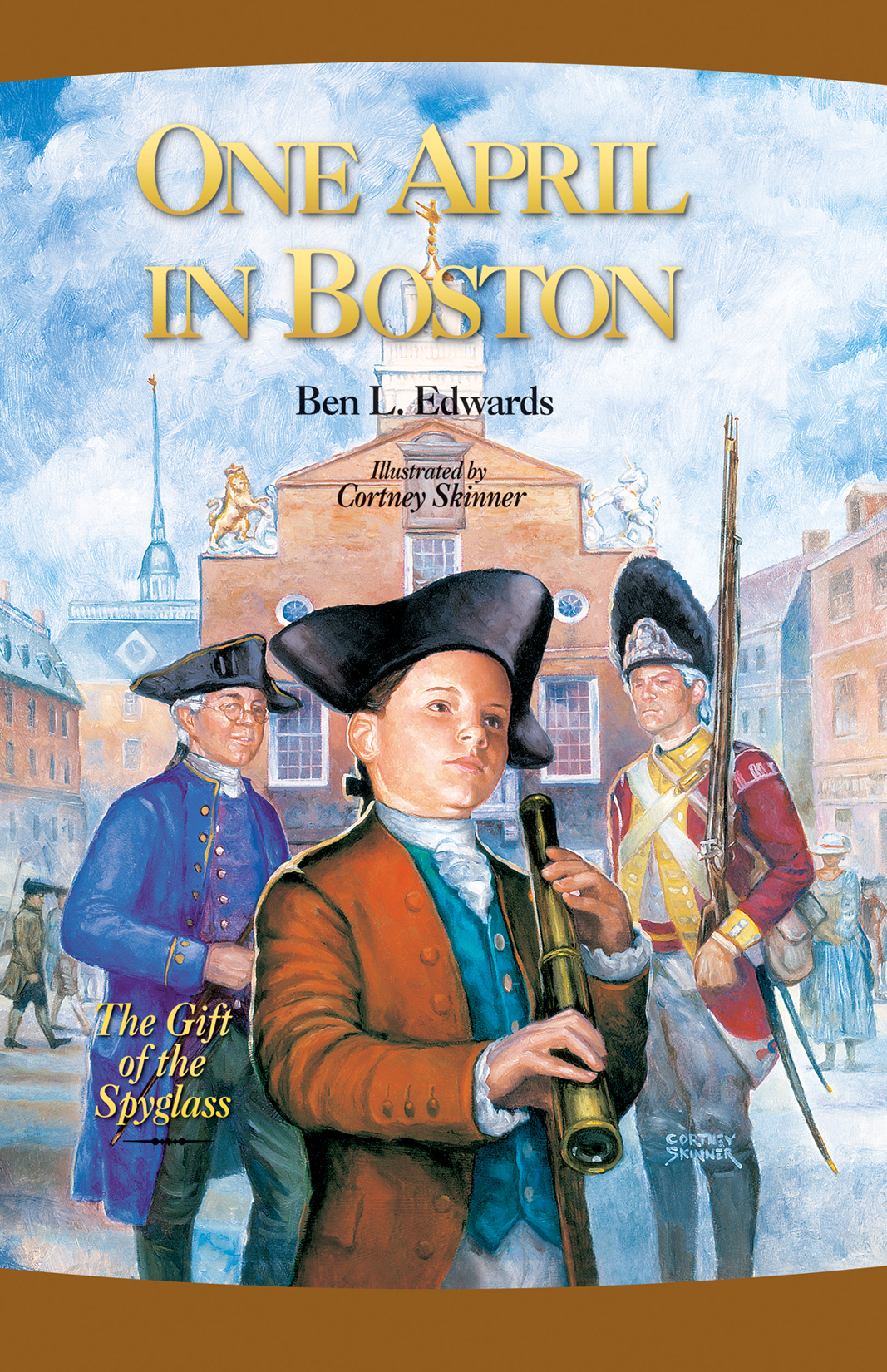One April in Boston
Making Pictures with Tiny Lines
Drawing in pen and ink is a matter of creating an illusion—it’s a collaboration between artist and viewer
by Cortney Skinner | 02.06.20
In my previous blog post on pen and ink, I covered the basics of the tools an artist uses. In this post, I’ll be talking about how lines are used to create the illusion of reality in a picture. I use the word “illusion” because that’s precisely what a pen and ink drawing is. Put plainly, pen and ink is a type of artwork where lines are drawn on a surface in such a way that the viewer sees shapes, objects, and a three-dimensional space. Though the artist creates the drawing, the “reality” of the scene is created by the mind of the viewer. It’s a collaboration between artist and viewer. Quite literally, the “art is in the eye of the beholder.”
Using line in artwork has a rich history of thousands of years, but my purpose in this blog post is to give a brief look at how lines work to create a picture.
The image below contains two examples. For the Paul Revere engraved bookplate (shown on the left) the artist drew lines to show the hairs in the lion’s mane but also used them to create gray areas in his family crest. In Revere’s time, in order to reproduce drawings, linework had to be hand-engraved on type-metal (an alloy of lead, antimony, and tin) or copper then inked and printed on paper. Daniel Vierge’s drawing of the man next to the carriage (seen on the right) shows how the artist left certain areas up to the imagination of the viewer. Though the wheels of the carriage are only partially drawn, we know that there’s an entire wheel there, not just a fragment. Only a few lines and dots tell us that the road is a dirt road, and, though nothing at all is drawn at the top of the picture, we know that’s the sky. We’re completing the drawing in our minds. The gray tones of the shadows created by parallel lines tell us that it’s a day with bright sun. In Vierge’s time (the 1890s) a photographer could take pictures of the original ink drawings and a printer could make plates containing those photos. The resulting prints in the book looked just like the original pen and ink drawings.
Drawing Style
Each of us can draw to some extent and each of us has our own style. Just what is drawing style? Training can determine that to a degree, but, as with handwriting, each artist has an individual style. Each of us has a unique range of movements in our arms, hands, and wrists which translate to an individual style in how we draw. Our personal preferences and how our minds work also contribute to our drawing style. Do we like detail? Do we fuss over tiny aspects of the drawing? Are we free and broad in our strokes or do we prefer control?
Planning the Picture
Since pen and ink is an unforgiving medium, and corrections are done only with difficulty, it pays to plan out how the picture will be done.
In the image below, you can see my master pencil drawing on the left and the resulting pen and ink drawing on the right. Before the pencil drawing was done, many small, rough pencil sketches (called thumbnails) were done, until a satisfying composition was arrived at. The soldier, Private Philip Edwards, was the focal point in the drawing, so I put him closest to the viewer. I wanted both the bleakness of the battlefield and the depth of the trench to show, so I chose a viewpoint that was high enough to reveal those two aspects.
Of course, research was an important part of this drawing. Every bit of the drawing had to be referenced: the battlefields and construction of trenches of WWI France, the uniforms and equipment of a U.S. soldier in the Great War—even the equipment of the German soldier was researched, since a few pieces of their equipage are seen in the trench: a gas-mask canister at the lower left and a broken Mauser rifle at lower right at the edge of the trench. I wanted the composition of the drawing to start at Phil receiving a cup of hot coffee from this fellow soldier, then lead the eyes up through the zigzag trench to the horizon where an unknown structure is burning.
The Drawing Workspace
Once the master pencil drawing was finalized and approved by Ben Edwards, I placed it on an LED tracing light pad seen in the photo below. This is the recent incarnation of a light table or light box. Those older versions had either incandescent or florescent bulbs in them with a translucent glass top. The pencil drawing is placed on the surface of the pad, which is lit from below, and then paper placed on top of the pencil drawing. The pencil drawing underneath acts as a guide for my pen and ink drawing on top. In the photo below, you can see the arrangement on my drawing board for doing the pen and ink drawing.
Creating the Pen and Ink Drawing
There are many techniques for creating a pen and ink drawing. My personal preference is a fairly detailed style. In the paragraph below is the finished drawing of the Liberty Tree lighting in 1766 Boston. This illustration did not appear in One April in Boston but was produced for another project I worked on with Ben. You can see that thicker outlines are used to make the man underneath the tree more distinct and stand out from the busy background. Thinner lines are used to show tones of gray up in the tree branches and the sky, and to create textures in the tree trunk and branches. My personal preference is to use very little crosshatching—a crisscrossing of ink lines. Some artists can use it in a masterful way, but yours truly isn’t very fond of my own crosshatching technique, so I stay away from it.
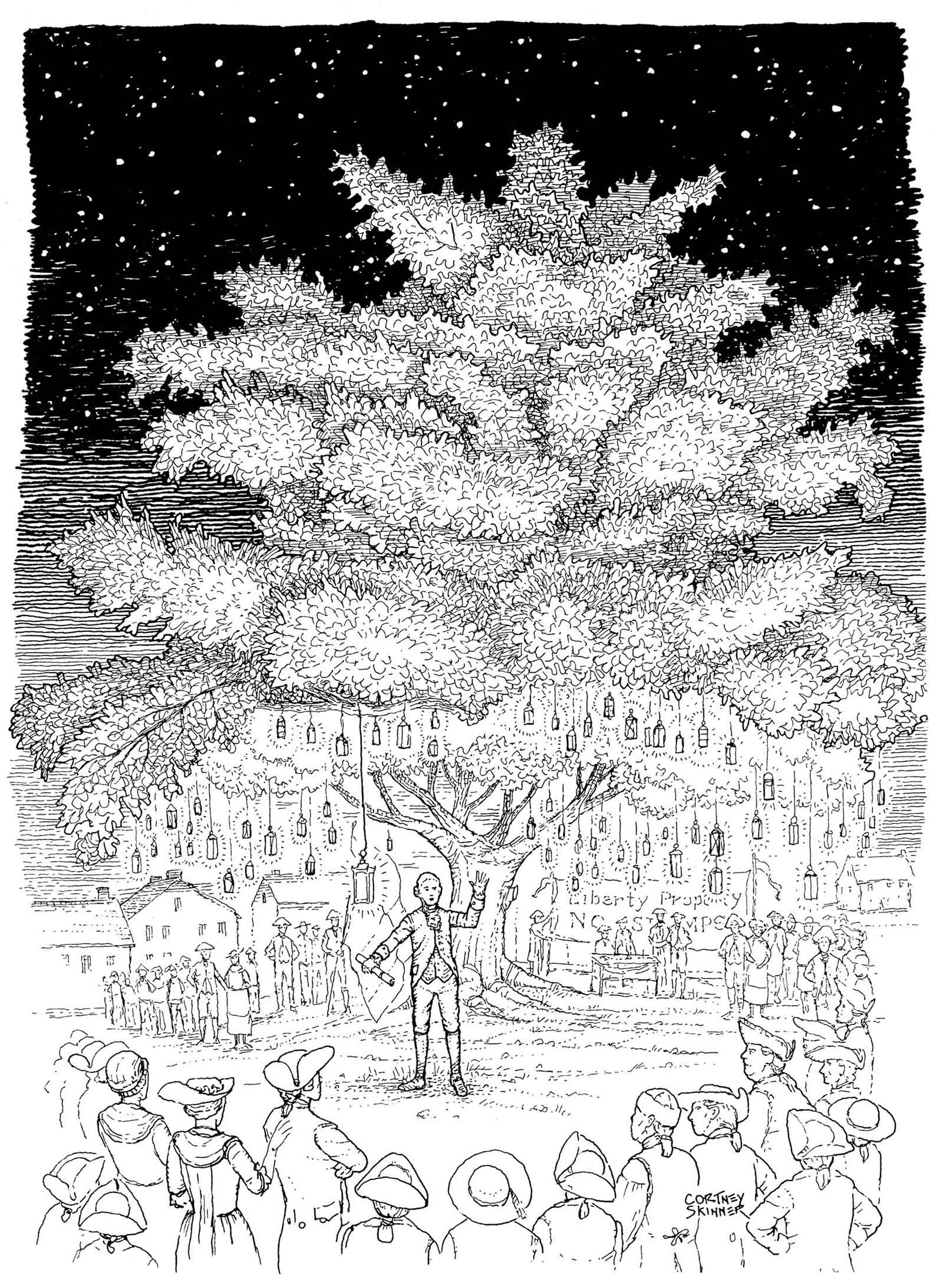 As I mentioned previously, the white of the paper can do some of the work in a pen and ink drawing, and the viewer completes the image. Take a look at the woman at lower left who has her right hand on the back of her husband. Even though I drew just four short lines, you know that it’s her hand and fingers there, not four black sticks. Further to the left of that couple, the crowd recedes into the distance, but even though the linework there is rudimentary, there’s no question that they’re people, not just abstract lines.
As I mentioned previously, the white of the paper can do some of the work in a pen and ink drawing, and the viewer completes the image. Take a look at the woman at lower left who has her right hand on the back of her husband. Even though I drew just four short lines, you know that it’s her hand and fingers there, not four black sticks. Further to the left of that couple, the crowd recedes into the distance, but even though the linework there is rudimentary, there’s no question that they’re people, not just abstract lines.
In some cases, an interesting texture can suggest details. Though not a single leaf is drawn in detail, using an almost decorative pattern suggests the grouping of leaves on the branches and boughs of Liberty Tree. Broken lines are another ink technique to create interest and to place an element into the background, as with the Bostonians in the back of the drawing. Had I drawn them with continuous, unbroken lines, they wouldn’t have receded into the background visually.
Not every detail needs to be delineated as can be seen in the background houses. Just suggesting the windows and walls is enough. The viewer completes the rest in their mind’s eye. The artist can use a detail to attract the viewer’s eye to a specific spot, as with the man giving the speech under the tree. “Open” pen work with plenty of white spaces can create an interesting, scintillating effect as evident around each glowing lantern hanging from the tree. Those radiating lines are a sort of shorthand understood by the viewer as glowing light. Using a brush, the black sky was filled in, leaving small open areas for the stars.
Though a laborious, intense process, a good pen and ink drawing can communicate a large amount of information using only black lines scratched on a piece of paper.
Buy the Book Here
Direct from the Author
Paul Revere House - Boston
About This Blog
The Spyglass Blog was created to mark the 20th anniversary of the children’s book One April in Boston. Here the author and illustrator share the stories behind the illustrations, give insight into the artistic process, and introduce related artwork Ben Edwards shares on his Walking Boston private tour. SpyglassBlog.com
Subscribe
Receive notice by email when a new post has been added to the Spyglass Blog.
Meet the Author
Boston’s only private guided walking tour with a children’s book author and relative of Paul Revere. Details below.
Family Tours
Three private tour options. A fun and educational tour of the Freedom Trail your children will love! BostonFamilyTour.com
Field Trips
Field trips for the 2019-2020 school year are Sold Out. Booking now for the fall of 2020. BostonFieldTrip.com
Homeschool Groups
A unique field trip for homeschoolers that teaches your children American history and inspires them to create goals. Homeschool-FieldTrip.com
